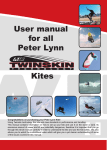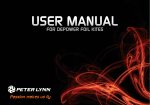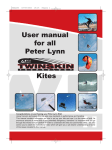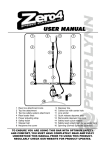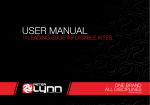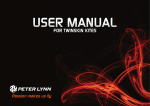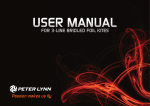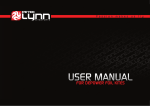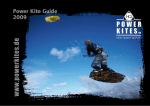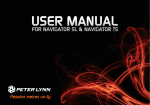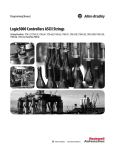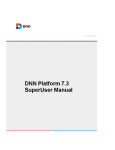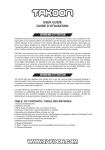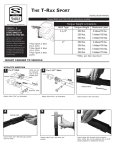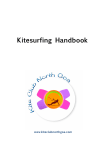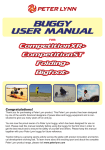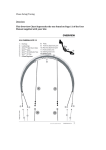Download USER MANUAL - A Wind Of Change
Transcript
USER MANUAL introduction Congratulations on purchasing a Peter Lynn GUERILLA! The Peter Lynn Guerilla kite is specially designed for kiteboarding. Using Twin Skin technology the Guerilla sets new standards in jumping, upwind performance and de-power. This manual contains information on how to set up your kite, and use it on the water. Its enormous amount of power and lift are potentially dangerous. Therefore it is important that you go through this whole manual carefully in order to understand the kite and use the kite safely. We also advice you to watch the Guerilla instruction video which will give you a yet clearer understanding of some of the issues covered in this manual. introduction [1] [2] [3] [4] [5] [6] [7] [8] [9] [1] [2] [3] [4] [5] Air intake vents Leading edge Top line attachment point Lower skin Top skin [6] [7] [8] [9] Tips Pockets with carbon rods Trailing edge Brake line attachment points Placing the sticks in and out of the kite The sticks can be taken in and out at the bottom of the pocket. To place them back in: 1. Undo the double velcro seal and slide in the stick all the way at the bottom. 2. Fold back the first velcro flap making sure the stick is in tight. 3. Close up the last velcro flap and you are ready to go! setting up the kite Starting off To start flying your Guerilla you need to follow the following procedure: 1. Placing the kite on the beach ready to pre-inflate 2. Attaching the lines 3. Launching Step 1. Pre-inflation 1. Take the kite out of the bag and roll the kite out. Place one tip on the ground and let the rest flap in the wind. Fold a small part of the tip over and place some sand on it. This part should not be too big, so as many cells as possible can inflate. 2. Open the zipper and make sure the air can flow in. While the kite is being preinflated you can start to get your flying lines ready to be attached to the kite. Step 2. Attaching the lines 1. Roll the leader lines off the bar and place everything flat on the ground. Roll out the flying lines in a straight line and attach them to the bar as shown in the bar manual. setting up the kite 2. Make sure the lines are free of twist and tangles. Now attach them to the kite as shown on the diagram. One set of lines should be attached to the line which runs through the center of the bar and to the top attachments on the kite. The other set of lines should be attached to the ends of the bar and to the bottom attachment points on the kite. Less bar pressure top line Brake line should be attached to the lower attachment brake line brake lin e top line Top line should be attached to the first knot More bar pressure Top line should be attached to the second knot Brake line should be attached to the higher attachment Connect the lines to the kite using the following method: a. Place a larkshead knot in the sleeve of the flying line. a. b. Slide the sleeve over the attachment lines on the kite. b. c. Tighten the larkshead knot and slide it towards the knot on the end of the attachment line. c. launching the kite Step 3. Launching the kite To launch your Guerilla lay it down in an area clear of other people, powerlines, airports, roads and railroads. Also check that there aren’t any sharp objects near the kite, as it may slide a little bit over the sand during launch. 1. Make sure there is enough pre-inflation inside the kite. Failure to do so will result in the kite to collapse during take off. Close the zipper. At the tip that is folded over, make sure the lines are running freely as shown on the photo on the right. 2. Check that your kite is ready for take off: lines are free of tangles, area is clear of people and other kite flyers. Take your bar and attach the safety leash to your harness. Always make sure to attach the safety leash before flying, so it can be used in case something goes wrong during the launch. 3. Make sure you stand at the correct position so your lines are at a 45 degree angle to the wind direction. (as shown below). Be careful: when there is tension on the flying line connected to the far tip the kite can take off at any time. Now you are ready to launch your Guerilla. launching and landing The launch 1. Make sure the far top and bottom line lie over the lowerskin of the kite and slowly pull the tip up. ! 2. Let the tip come up further. Keep your rear lines tensioned. Take a few steps back. The kite will slide back and get into shape. 3. Once the kite is off the ground keep the rear lines slightly tensioned until it has filled up with air. Let the kite slowly fly up to the zenith. • Make sure you are not launching in an area with obstacles like poles or cars, make sure the area is free of people or other kiteflyers. Do not fly your kite near powerlines, airports, highways, or in thunderstorms. • Make sure the ground is free of sharp objects to prevent the fabric from damaging. • The Guerilla can collapse during the launch when it is not completely filled up with air. • Keep the rear lines tensioned until the kite is completely filled up. • Pre-inflate the kite properly. The more you pre-inflate the easier the launch. • Do not launch while hooked into a harness. • When in doubt of the wind strength, try a smaller kite first. • Check your lines properly, make sure they are free of twists and tangles. Landing Landing your Guerilla can be done in two ways: - Fly your kite all the way to the edge of the wind window, and slowly steer it down to the ground. An assistant can then grab the spar closest to the ground and after releasing the tension on your lines the Guerilla flaps in the wind. - Fly your kite to the edge of the wind window and slowly bring it down close to the ground. Make sure you are not landing your kite in an area with poles or other sharp objects on the ground. Activate your safety system. The kite will lose its shape and fall on the ground. flying techniques Using the bar The power of your Guerilla can easily be controlled with the bar. When the depower loop is hooked in, the bar can slide over the depower line which changes the angle of attack causing the kite to produce more or less power. When sheeting out the bar the power of the kite decreases. Using the power adjuster To change the overall power of the kite the power adjuster can be used. This can be done on and off the water, even while surfing. Pull in the line to reduce the overall power of the kite, sheet out to increase the power of the kite. When pulling in the bar the power of the kite increases. Sheeting out (blue arrow) This causes the kite to produce more power overall. Pull the end of the loop shown with the blue arrow (the end with the ‘PETER LYNN’ writing) towards you and release forward. The clip slides away in small portions. Repeat the process until you find the right setting. Pulling in (red arrow) This causes the kite to produce less power overall. Pull the end of the loop shown with the red arrow towards you. The clip is pulled towards you and locks in. ! • To make tighter turns, pull the bar a bit more towards the body when steering. • Slowly bring back the kite straight above your head when things get out of hand. This is a secure area where the pull is the smallest. • Do not fly your kite straight through the center of the wind window. flying techniques Top/Brake line adjustments Adjusting your lines is very important. Some people prefer to fly with loose brake lines, some people prefer to fly their Guerilla with tighter brake lines. The best method is to fly your Guerilla and try different settings using the power adjuster. These are some guidlines that might help: • • If the kite stalls frequently, your brake lines are too tight. Shorten the lines on the top attachments of the kite. If the kite steers very slow, your brake lines are too loose. Shorten the leader lines on your bar. When your Guerilla stalls, reach forward and jerk the top lines until the kite gets moving. When setting your kite you can also devide the depower line into 3 regions. (see image) region 1: your kite should now be fully depowered, with the brake lines hanging slack. region 2: this is the standard position where you are holding your bar when surfing. region 3: now the kite should stall slightly. 1 2 3 How to do the adjustments Adjustments can be done with the power adjuster, but for a more permanent adjustment (and full use of the power adjuster while surfing) the length of the leader lines should be adjusted by moving the knot on the end or by placing extra knots in the line. Inverting Very occasionally when the Guerilla overflies completely and then drifts back it may invert, so the back skin is facing the flyer. The kite will fly inverted. Land the kite nose down, allow it to roll over and then relaunch the kite. Packing When you wish to stop using your kite, roll in the lines on your controlbar and take the lines off the kite. Open zipper in the centre, fold the kite tip to tip with the top skin on the outside. Roll up the kite starting at the tips, squeezing the air out through the zipper. ! Even when stopping for a short period of time, we would recommend you to roll up your kite, instead of leaving it flat on the beach. UV rays damage the fabric. The constant flapping of the downwind tip will weaken the fabric in this area. When the kite is still wet after usage, make sure it is dry before storing it. Make sure you store your kite in the specially designed Guerilla bag, to make sure the kite is not damaged while not in use. water relaunch Tip on tip 1 1. The kite lies on the water tip on tip. 2 2. Pull the brake line of the bottom tip. The kite will open up... 3 3. ...regaining its shape. Now just steer the kite off the water. Kite on its leading edge 1 1. The kite lands with its leading edge on the water. 2 2. Pull in on one backline so the kite rolls over onto one tip. 3 3. Now you can follow the tip on tip relaunch to finish off the procedure. After a water relaunch fly the kite up the zenith. If water has seeped into the kite, keep the kite above your head till the water has dribbled out through the tips. Then continue surfing. safety systems Safety systems When the surfer wishes to loose the power of the kite without losing the kite itself the safety system can be activated. A safety system can be very usefull in situations where for example the rider gets out of control or the wind suddenly picks up. When the safety system is activated, the kite loses its shape and falls down on to the water. Using your safety system To activate your safety system, you need to unhook from the depower line. This can be done by unhooking the depower loop or using the safety release by pulling on the red loop. The depower line and the bar are now released from the rider. The bar will slide forward on the line that is connected to the safety leash. This creates a difference in line length, one side of the tip will be held on while the other is not. The kite loses its shape and falls down on the water. Using the safety leash quick release When the kite is still pulling, even after using the safety system, there is a safety release on the leash. This is very usefull when two kites are tangles up into each other. To disconnect the leash from your harness, pull on the red webbing on the snap shakle. ! • When getting a bit overpowered, slowly bring back the kite straight above your head. Only try to use your safety system when things gets out of hand. • When your kite is on the water, always be very carefull with flying lines which are not tensioned. Make sure they do not get tangled behind any part of your body, harness or board. • After using your safety system, putting tension on any of the other lines means your kite can take off and start to pull. safety instructions Safety precautions Safe Location: • • • • stay away from power lines, roads, airfields, railway lines never launch your kite on crowded beaches do not fly over bystanders make sure there is a ‘clear’ downwind area at least three times the distance of your flying line length Safe weather conditions: • never fly kites in thunderstorms, lightning or gusty/stormy winds • do not go kitesurfing in offshore winds Safe kiteboarding: • we strongly recommend the use of helmet and life jacket/impact vest. Also a safety knife to cut flying lines in case of emergency is recommendable. • do not kiteboard in spots already in use by swimmers, surfers or windsurfers • stay safely away from other watercraft and shipping lanes. • never go further out to sea than you can safely swim back • always make sure there is a capable person on shore that is keeping watch and is ready to provide (or call for) help in case of an emergency. • powerkites are no toy’s, they should not be flown by inexperienced persons and certainly not by children. • learn to fly kites with smaller models and start in light winds. • never use kites for paragliding or parachuting. • never use the Guerilla or any other type of kite or kite accessory for jumping off high places or any other manlifting activity More about Peter Lynn products There is a whole range of kiteboarding products available from Peter Lynn. For more info on these products or any other questions, please visit: http://www.peterlynnkiteboarding.com/












